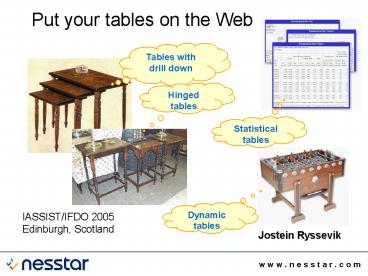NESSTAR Networked Social Science Tools and Resources PowerPoint PPT Presentation
Title: NESSTAR Networked Social Science Tools and Resources
1
Put your tables on the Web
IASSIST/IFDO 2005 Edinburgh, Scotland
Jostein Ryssevik
2
Topics
- Aggregated (tabular) data versus micro-data
- Basic properties of aggregated data
- Metadata standards for describing tabular data
- The tabular data implementation in Nesstar
- Demo
3
Micro-data versus aggregated data
4
Relationships from simple to complex
5
Aggregated data - features
6
Aggregated data - features
It is also nice to be able to slice the data cube
cut trough the data cube on one or more of the
dimensions. In the example below we have sliced
the cube on the time dimension, now only showing
data for 2002
7
Aggregated data - features
8
Aggregated data an overview
- .typically derived from one or more micro-data
source though an aggregation process - .has a logical structure which is quite
different from micro-data - .should not be understood as a table, rather
as a dataset from which hundreds of different
table displays can be derived - Aggregated data (as most data) are best
understood by separating the logical structure of
the data from storage as well as presentation.
9
A three-layered model
10
The twin roots of the DDI cube specification
- The Vorburg compromise
- a great achievement, but
- have been lacking some of the logic needed to
drive functionality-rich tabulation system/OLAP
systems. - a rigid relationship to the surveydata-oriented
study concept.
11
The Nesstar implementation
- Nesstar is a general purpose system for
publishing and sharing statistical information on
the Web. - A specific feature of Nesstar is the support for
different logical data models.
12
Live tables are great fun.
PowerShow.com is a leading presentation sharing website. It has millions of presentations already uploaded and available with 1,000s more being uploaded by its users every day. Whatever your area of interest, here you’ll be able to find and view presentations you’ll love and possibly download. And, best of all, it is completely free and easy to use.
You might even have a presentation you’d like to share with others. If so, just upload it to PowerShow.com. We’ll convert it to an HTML5 slideshow that includes all the media types you’ve already added: audio, video, music, pictures, animations and transition effects. Then you can share it with your target audience as well as PowerShow.com’s millions of monthly visitors. And, again, it’s all free.
About the Developers
PowerShow.com is brought to you by CrystalGraphics, the award-winning developer and market-leading publisher of rich-media enhancement products for presentations. Our product offerings include millions of PowerPoint templates, diagrams, animated 3D characters and more.

